User-generated content has always held a special place in brands’ marketing efforts
From Coca-Cola’s 2012 Share a Coke campaign that still has more than 600k hashtag uses on Instagram to those endearing Pampers commercials that utilize user-submitted videos, including UGC in a campaign or on a website is never a bad idea. And the best part is, in 2021, it’s a marketing strategy available to absolutely every brand out there. Perhaps even more importantly, it’s a tactic that works.
So why exactly is user-generated content so effective? And how can you use it to get the absolute best benefits for your business? Let’s find out.
What Is UGC?
The best way to define user-generated content is to say that it is any format of content used by a brand but created by someone not employed by the organization in question.
UGC can be a wide variety of things, from social media posts to visuals and videos about a brand or its products. Furthermore, it can also include testimonials and even some media mentions.
The only condition when classifying something as UGC is that customers submit it for free.
What Can UGC Do for Your Business?
According to the State of User-Generated Content Report 2021, as many as 93% of marketers believe that consumers trust UGC more than they do content created by brands. Considering that trust is one of the main drivers of purchasing decisions, this is not a statistic that can be lightly disregarded.
But trust, in itself, is not the only reason to utilize UGC on your website or social media profiles.
A data report by Stackla, published in 2019, found that 90% of consumers cited authenticity as a factor when deciding what brands to support. And, it turns out that to 51% of people, less than half of brands are successful at creating genuine content. UGC, on the other hand, is 2.4x more likely to be perceived as authentic.
And, of course, it would be foolish to disregard the impact UGC can have on website conversions.
According to The Conversion Impact of User-Generated Content by Power Reviews, 97% of consumers read product reviews in 2020. 88% looked for photos and videos provided by other consumers. And, most importantly, consumer interactions with UGC resulted in a 108.4% lift in conversion rates.
From this data alone, it’s easy to understand that user-generated content plays a significant role in all stages of the customer journey. It can benefit brands from the very beginnings of the research phase to the moment of making a sale. And, it can even play a part in keeping existing customers engaged, loyal, and a reliable source of both income and word-of-mouth social proof.
So how can you effectively use UGC in your campaigns? And is there a difference to what works in various niches? The following are the best ways to implement user-generated content on your digital channels.
Using UGC in Ecommerce: Build Trust & Create Hype
There are many strategies you can implement to make your online store outperform the competition. But the thing is, one of the easiest ways to drive success in ecommerce is to incorporate different forms of UGC.
Social proof on websites
The most widespread application of user-generated content in ecommerce is adding testimonials to homepages, landing pages, or product pages. Used as a sales tactic, this type of social proof can be powerful in describing the quality and effectiveness of your product.
It can be used to show off reviews, satisfaction rates, and, most importantly, real-life applications of your product, like in the example below by SomniFix.
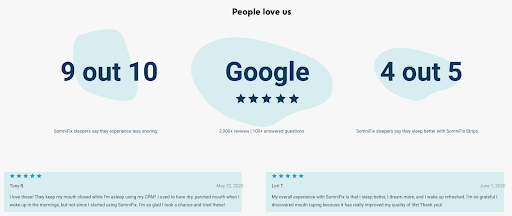
This brand decided to single out two user-written pieces of feedback on its homepage. Consequently, SomniFix managed to show that its product works well for CPAP users and contributes to better sleep quality. There is an entire Reviews page on SomniFix’s website dedicated to UGC, but bringing this type of content to the homepage makes it more likely that web visitors will notice the feedback. Plus, it increases the brand’s chances of attracting new buyers.
Sharing UGC on social media
Displaying user reviews is not the only way for ecommerce brands to utilize UGC. Another great tactic is to collect user-submitted videos and images and share them on social media to boost post engagement rates.
Transparent Labs is an outstanding example of an ecommerce brand that does just this. With a social media strategy entirely focused on real-life users, this brand collaborates with several influencers, ranging from celebrities like Game of Thrones’ The Mountain to nano-influencers like powerlifter Maria Htee.

Essentially, what Transparent Labs does on its Instagram page is that it regularly re-posts UGC made by its collaborators and customers, building a trustworthy brand image that rests on a combination of social proof and science-backed claims. And, it just so turns out that user-submitted photos and videos play a significant part in achieving this effect.
Supporting claims with UGC
Finally, it’s also possible for ecommerce brands to use UGC from any social media or distribution platform if it can support their claims. From Twitter to Reddit to YouTube, people will share their opinions and brand experiences. And, if these can help drive success for your business, why not make use of them? (With the original poster’s permission, of course).
For a great example of how far you can go with UGC, check out the latest campaign by GoPro. The brand reached out to 9 content creators to collaborate on the launch of the HERO10 Black camera.
The result of the UGC-based campaign wasn’t just a series of stunning videos that fully show off the product’s capabilities. But more importantly, the collaboration generated a considerable amount of hype around a brand new product, resulting in over 600k views.
UGC for SaaS: Solve User Problems & Show the Vast Potential of Your Software
Now, if what you’re offering to customers isn’t a physical product but a software solution, you can rest assured that UGC can help you start conversations, drive follower engagement, and even generate conversions on your website.
Because SaaS centres around finding solutions to widespread (or niche) user needs, it’s the perfect industry for collecting and sharing diverse experiences. These won’t just testify to the effectiveness of your software. Perhaps even more importantly, they can help educate potential customers or even offer them value that they wouldn’t get elsewhere.
Example #1: Finli
A standard example of how UGC can help you educate your audience comes from Finli. This brand offers an all-in-one payment management system that helps small businesses streamline their payments and bookings. But, what sets Finli apart from its competitors is a community-based approach that aims to empower.
One way Finli does this is by including an “Ask Finli” feature on its blog. Here, it collects and answers user-submitted questions about payment management for small businesses.
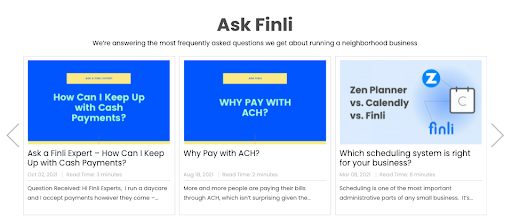
But that’s not the only way the brand implements UGC in its marketing strategies. It also partners with content creators on YouTube, working with them to create insightful tips on starting and running a successful business. Then, the brand shares these videos on different distribution platforms, maximizing their reach and ensuring that they’re seen by as many people as possible.
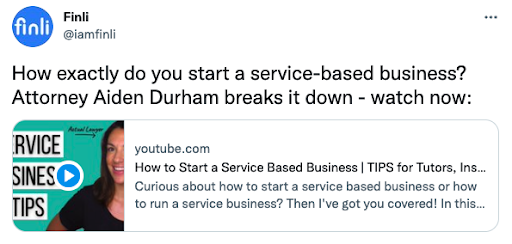
Example #2: Notion
Of course, there are other ways to use UGC in SaaS as well.
Notion is a brand that doesn’t just use UGC to reach or engage with its audiences, but it even makes UGC an irreplaceable part of its unique value proposition.
As an all-in-one workspace, this software company includes an extensive template gallery on its website. And, sure, there’s a good number of pages made by the company’s internal team. However, what really steals the spotlight are the user-generated dashboards. These include pages submitted by fellow SaaS companies like Headspace, LinkedIn, and Buffer to those put together by influencers or just everyday people who have managed to create systems to keep track of professional projects, note-taking, or personal finance.
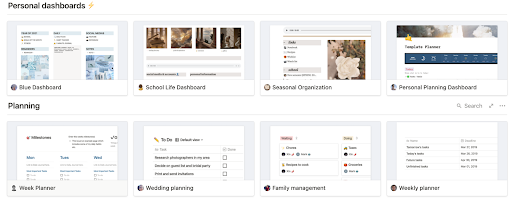
UGC for Membership Sites: Inspire & Build Communities
What do you do when your product/service doesn’t revolve around single transactions but around continuing relationships with your customers?
In these cases, your aim shouldn’t just be to acquire new leads but to nurture old ones as well. And including user-generated content in your marketing strategy might just be the way to go if you’re after sustainable growth.
One of the wonderful ways that UGC benefits businesses is that it helps them build meaningful relationships with their users. And the best part is, this can be done in so many different ways.
Example #1: Airbnb
There’s Airbnb with its inspiring Experiences page that showcases exciting programs created by hosts and invites travelers to explore them – whether on location or from the comfort of their homes.
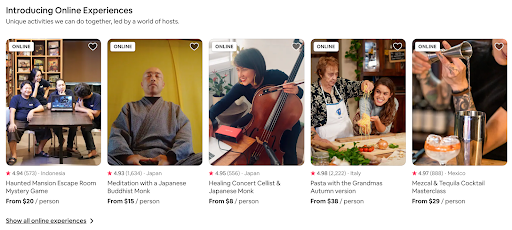
The entire page relies on user-generated content, yet it still manages to encourage connection, underlining just how important the role of the membership site, Airbnb, is in enabling these relationships and adventures.
Example #2: Skillcrush
Then, there are educational programs that use user-submitted content to encourage subscribers to go after their dreams.
Skillcrush is an excellent example of such a platform. It features an entire site section dedicated to reviews, articles, and videos posted by graduates who have success stories to share with people in similar positions to theirs.
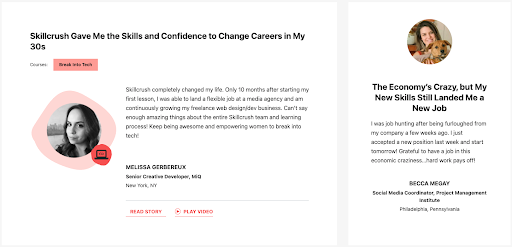
By pointing out challenges and describing strategies for overcoming them, Skillcrush is getting impressive results. And that’s all thanks to UGC, which gives web visitors a face to identify with and a community to belong to.
Example #3: Behance
Finally, it’s important to note that user-generated content isn’t just something that can make existing businesses achieve better conversions or reach the right audience. If you check out Behance, you’ll quickly realize that it can be an entire business idea, driven by inviting people to submit their creations and offering them a platform to be seen and heard by people in their industry.
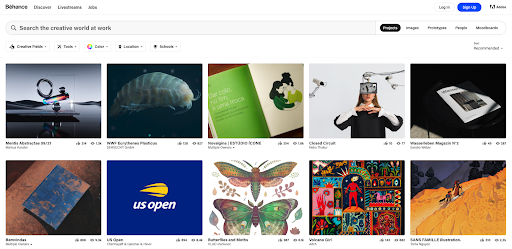
Wrapping up
As you can see, there are various ways to use UGC. It can help you support your brand claims and be a great way to offer value to your audience or even a feature of your product/service.
So, go ahead and think about how you can make user-generated content a part of your online marketing strategy. Even if you only decide to show user reviews on your product pages or do the occasional retweet, you’ll be seeing gains. And, when running a business, every sale matters. Even the smallest one.





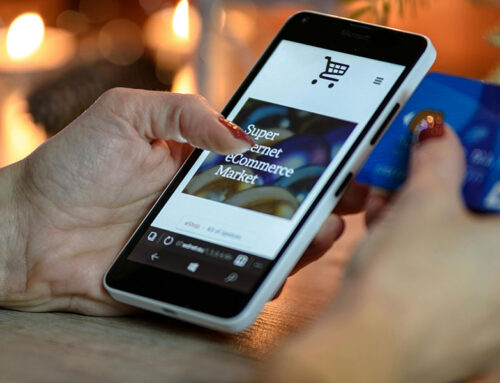
Leave A Comment